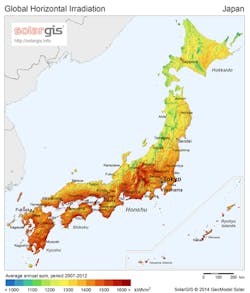Japan has budgeted $7 million per year for three years on microgrid demonstration projects, as part of a post-Fukushima effort to smarten the electric grid, according to a report by GlobalData.
As it boosts energy efficiency and renewables, the nation appears destined to become one of Asia-Pacific’s top markets in smart grid development, says the research and consulting firm.
Japan was among the first countries globally to invest in smart grid research and development in the early 2000s. The New Energy and Industrial Technology Development Organization (NEDO) has funded several pilot microgrid projects since 2003. Last year, the Ministry of Energy started a new program to encourage further microgrid development, according to the report.Funding is available for independent demonstration projects that include such technology as electric vehicles for mobility and storage, renewable energy production and storage systems, and energy efficiency optimization.
“Following the Fukushima nuclear disaster in 2011, Japan suffered substantial damage to its grid infrastructure, along with a reduction in its base load generation. Consequently, there are more efforts to increase the country’s energy efficiency and renewable power generation,” said Sowmyavadhana Srinivasan, GlobalData’s senior analyst covering power.
However, the sector faces some roadblocks.
“The proliferation of renewable power projects in Japan is hindered by numerous difficulties with connecting to the grid, which is currently divided into 10 regions and operated by 10 different utilities. One of the major challenges for developers in 2014 was the requirement for an improved transmission system,” Srinivasan said.
This is compounded by the fact that it has taken around three to four years for developers to overcome all regulatory hurdles involved in implementing renewable projects, according to GlobalData.
The good news is that the Japanese government as reduced the waiting period to less than two years. Establishing a centralized grid will shorten the wait even more, according to the research firm.
Renewable energy accounted for 10 percent of Japan’s total installed capacity in 2014; GlobalData forecasts that the resource will grow to 19 percent by 2025.
Follow MicrogridKnowledge.com on Twitter @MicrogridNews.
